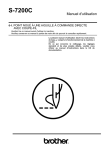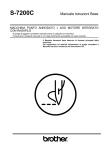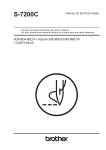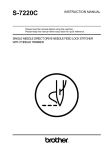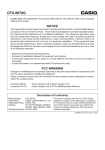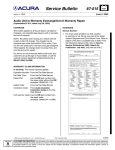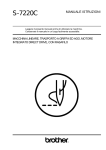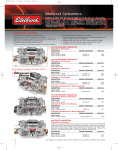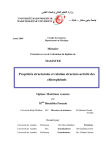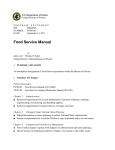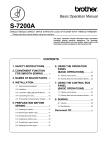Download Brother S-7200C Instruction manual
Transcript
S-7200C Basic Operation Manual SINGLE NEEDLE DIRECT DRIVE STRAIGHT LOCK STITCHER WITH THREAD TRIMMER Please read this manual before using the machine. Please keep this manual within easy reach for quick reference. This basic operation manual describes basic operations including sewing machine operations. For cleaning, standard adjustments and more details, please refer to the instruction manual contained in the Document CD. Thank you very much for buying a BROTHER sewing machine. Before using your new machine, please read the safety instructions and the explanations given in the instruction manual. With industrial sewing machines, it is normal to carry out work while positioned directly in front of moving parts such as the needle and thread take-up, and consequently there is always a danger of injury that can be caused by these parts. Follow the instructions from training personnel and instructors regarding safe and correct operation before operating the machine so that you will know how to use it correctly. S-7200C SAFETY INSTRUCTIONS [1] Safety indications and their meanings This instruction manual and the indications and symbols that are used on the machine itself are provided in order to ensure safe operation of this machine and to prevent accidents and injury to yourself or other people. The meanings of these indications and symbols are given below. Indications DANGER The instructions which follow this term indicate situations where failure to follow the instructions will result in death or serious injury. CAUTION The instructions which follow this term indicate situations where failure to follow the instructions could cause injury when using the machine or physical damage to equipment and surroundings. Symbols ····· This symbol ( ) indicates something that you should be careful of. The picture inside the triangle indicates the nature of the caution that must be taken. (For example, the symbol at left means “beware of injury”.) ····· This symbol ( ····· This symbol ( ) indicates something that you must do. The picture inside the circle indicates the nature of the thing that must be done. (For example, the symbol at left means “you must make the ground connection”.) ) indicates something that you must not do. S-7200C i [2] Notes on safety DANGER Wait at least 5 minutes after turning off the power switch and disconnecting the power cord from the wall outlet before opening the cover of the control box. Touching areas where high voltages are present can result in severe injury. CAUTION Environmental requirements Use the sewing machine in an area which is free from sources of strong electrical noise such as electrical line noise or static electric noise. Sources of strong electrical noise may cause problems with correct operation. Any fluctuations in the power supply voltage should be within ±10% of the rated voltage for the machine. Voltage fluctuations which are greater than this may cause problems with correct operation. The power supply capacity should be greater than the requirements for the sewing machine's power consumption. Insufficient power supply capacity may cause problems with correct operation. The ambient temperature should be within the range of 5°C to 35°C during use. Temperatures which are lower or higher than this may cause problems with correct operation. The relative humidity should be within the range of 45% to 85% during use, and no dew formation should occur in any devices. Excessively dry or humid environments and dew formation may cause problems with correct operation. In the event of an electrical storm, turn off the power and disconnect the power cord from the wall outlet. Lightning may cause problems with correct operation. Installation Machine installation should only be carried out by a qualified technician. Contact your Brother dealer or a qualified electrician for any electrical work that may need to be done. The sewing machine weighs more than 45 kg. The installation should be carried out by two or more people. Do not connect the power cord until installation is complete. The machine may operate if the treadle is depressed by mistake, which could result in injury. Turn off the power switch before inserting or removing the plug, otherwise damage to the control box could result. Be sure to connect the ground. If the ground connection is not secure, you run a high risk of receiving a serious electric shock, and problems with correct operation may also occur. When securing the cords, do not bend the cords excessively or fasten them too hard with staples, otherwise there is the danger that fire or electric shocks could occur. ii S-7200C If using a work table which has casters, the casters should be secured in such a way so that they cannot move. Secure the table so that it will not move when tilting back the machine head. If the table moves, it may crush your feet or cause other injuries. Use both hands to hold the machine head when tilting it back or returning it to its original position. If only one hand is used, the weight of the machine head may cause your hand to slip, and your hand may get caught. Be sure to wear protective goggles and gloves when handling the lubricating oil and grease, so that they do not get into your eyes or onto your skin, otherwise inflammation can result. Furthermore, do not drink the oil or eat the grease under any circumstances, as they can cause vomiting and diarrhea. Keep the oil out of the reach of children. CAUTION Sewing This sewing machine should only be used by operators who have received the necessary training in safe use beforehand. Attach all safety devices before using the sewing machine. If the machine is used without these devices attached, injury may result. The sewing machine should not be used for any applications other than sewing. Do not touch any of the moving parts or press any objects against the machine while sewing, as this may result in personal injury or damage to the machine. Be sure to wear protective goggles when using the machine. If goggles are not worn, there is the danger that if a needle breaks, parts of the broken needle may enter your eyes and injury may result. Turn off the power switch at the following times. The machine may operate if the treadle is depressed by mistake, which could result in injury. y When threading the needle y When replacing the bobbin and needle y When not using the machine and when leaving the machine unattended If using a work table which has casters, the casters should be secured in such a way so that they cannot move. Secure the table so that it will not move when tilting back the machine head. If the table moves, it may crush your feet or cause other injuries. Use both hands to hold the machine head when tilting it back or returning it to its original position. If only one hand is used, the weight of the machine head may cause your hand to slip, and your hand may get caught. If an error occurs in machine operation, or if abnormal noises or smells are noticed, immediately turn off the power switch. Then contact your nearest Brother dealer or a qualified technician. If the machine develops a problem, contact your nearest Brother dealer or a qualified technician. Cleaning Turn off the power switch before carrying out cleaning. The machine may operate if the treadle is depressed by mistake, which could result in injury. Secure the table so that it will not move when tilting back the machine head. If the table moves, it may crush your feet or cause other injuries. Use both hands to hold the machine head when tilting it back or returning it to its original position. If only one hand is used, the weight of the machine head may cause your hand to slip, and your hand may get caught. Be sure to wear protective goggles and gloves when handling the lubricating oil and grease, so that they do not get into your eyes or onto your skin, otherwise inflammation can result. Furthermore, do not drink the oil or eat the grease under any circumstances, as they can cause vomiting and diarrhea. Keep the oil out of the reach of children. Use only the proper replacement parts as specified by Brother. Maintenance and inspection Maintenance and inspection of the sewing machine should only be carried out by a qualified technician. Ask your Brother dealer or a qualified electrician to carry out any maintenance and inspection of the electrical system. Turn off the power switch and disconnect the power cord from the wall outlet at the following times, otherwise the machine may operate if the treadle is depressed by mistake, which could result in injury. y When carrying out inspection, adjustment and maintenance y When replacing consumable parts such as the rotary hook If the power switch needs to be left on when carrying out some adjustment, be extremely careful to observe all safety precautions. S-7200C Secure the table so that it will not move when tilting back the machine head. If the table moves, it may crush your feet or cause other injuries. Use both hands to hold the machine head when tilting it back or returning it to its original position. If only one hand is used, the weight of the machine head may cause your hand to slip, and your hand may get caught. Use only the proper replacement parts as specified by Brother. If any safety devices have been removed, be absolutely sure to re-install them to their original positions and check that they operate correctly before using the machine. Any problems in machine operation which result from unauthorized modifications to the machine will not be covered by the warranty. iii [3] Warning labels The following warning labels appear on the sewing machine. Please follow the instructions on the labels at all times when using the machine. If the labels have been removed or are difficult to read, please contact your nearest Brother dealer. 1 2 Touching areas where high voltages are present can result in severe injury. Turn off the power before opening the cover. 3 * Safety devices: 4 Be careful not to get your hands caught when returning the machine head to its original position after it has been tilted. 5 Be careful to avoid injury from the moving thread take-up. 6 Be sure to connect the ground. If the ground connection is not secure, you run a high risk of receiving a serious electric shock, and problems with correct operation may also occur. 7 Direction of operation (A) Finger guard (B) Thread take-up cover Oil pan Control box iv Transformer box (100 V/400 V system only) S-7200C 4123M CONTENTS 1. CONVENIENT FUNCTION FOR SMOOTH SEWING ............................... 1 5. USING THE G50 OPERATION PANEL (BASIC OPERATIONS) ........................ 20 2. NAMES OF MAJOR PARTS................. 2 5-1. Names and functions ........................................20 5-2. Sewing start and end backtack stitches............22 3. INSTALLATION .................................... 3 3-1. Table processing diagram ................................ 4 3-2. Installation......................................................... 4 3-3. Lubrication (-[]0[], []3[] specifications)............... 8 3-4. Connecting the cords........................................ 9 3-4-1. Opening the control box cover............. 9 3-4-2. Connecting the cords........................... 9 3-5. Test operation (Operating the treadle) ............. 14 3-6. Adjusting the treadle......................................... 15 6. SEWING ................................................ 23 6-1. Sewing ..............................................................23 6-2. Backtacking.......................................................23 Document CD ........................................... 25 4. PREPARATION BEFORE SEWING ..... 16 4-1. Installing the needle.......................................... 16 4-2. Removing the bobbin case ............................... 16 4-3. Winding the lower thread.................................. 17 4-4. Installing the bobbin case ................................. 17 4-5. Threading the upper thread .............................. 18 4-6. Adjusting the stitch length................................. 19 4-7. Using the thread wiper (-4[][] secifications) ...... 19 4-8. Using the knee lifter.......................................... 19 S-7200C 1. CONVENIENT FUNCTION FOR SMOOTH SEWING 1. CONVENIENT FUNCTION FOR SMOOTH SEWING Thread take-up amount can be adjusted Lower thread counter (When using the G50 operation panel) INSTRUCTION MANUAL CD 10-4. Adjusting the thread take-up amount INSTRUCTION MANUAL CD 5-7. Using the lower thread counter The graphic display lights and a buzzer sounds before the bobbin thread runs out, so that the operator can concentrate on the job with confidence. When sewing heavy materials, the thread tension can be adjusted more easily if the thread take-up amount is set to a larger amount. (-[][]3 specifications only) Easy setting of sewing speed from operation panel < When using the G50 operation panel > Page 21 The sewing speed can be adjusted using the sewing speed control keys. <G50 operation panel> < When using the G10 operation panel > INSTRUCTION MANUAL CD 8-5. Setting the maximum sewing speed The sewing speed can be adjusted using the MAX key. Selectable starting speed The sewing speed at the sewing start can be selected in accordance with the treadle depression amount. You can set the speed according to the preferences of the operator. (Contact the place of purchase.) Condensed stitching INSTRUCTION MANUAL CD 9-3. Sewing condensed stitches This feature is ideal for use when sewing thin materials that can easily pucker when reverse stitches are sewn. Condensed stitches have a smaller sewing pitch and they help prevent fraying. 4316M Actuator switch Sewing direction INSTRUCTION MANUAL CD 13-1. Adjusting the actuator switch position The installation position for the actuator switch can be adjusted to <A> or <B>. Adjust so that it is in a position where it is easy to operate. Condensed stitches 3165M Floating presser foot for easy handling INSTRUCTION MANUAL CD 13-12. Adjusting the presser foot floating amount Maximum presser foot lift amount 16 mm The knee lifter and the needle up stop (reverse rotation) function together provide 16 mm of space underneath the presser foot. This makes it much easier to insert and remove heavy material without it getting caught on the needle. (Contact the place of purchase.) A micro-adjustable type floating presser foot is equipped as standard. This device is ideal for controlling presser foot floating in materials that stretch easily and materials with long pile. It prevents seam slippage and also prevents damage to the material. In addition, three-dimensional articles with irregular curves can also be handled with ease. 3721M 4314M 1 S-7200C 2. NAMES OF MAJOR PARTS 2. NAMES OF MAJOR PARTS G50 operation panel (advanced function LCD) G10 operation panel (basic function LED) 4124M (1) (3) (5) (7) (9) (11) (13) (15) Bobbin winder Lifting lever Presser foot Power switch Reverse lever Oil feeding pocket (-[]0[]・[]3[]specifications) Operation panel Control box Safety devices (16) Thread take-up cover (2) (4) (6) (8) (10) (12) (14) Thread wiper (-4[][] specifications) Actuator switch Knee lifter assembly Oil gauge window (-[]0[], []3[] specifications) Stitch length dial Machine pulley Cotton stand (17) Finger guard S-7200C 2 3. INSTALLATION 3. INSTALLATION CAUTION Machine installation should only be carried out by a qualified technician. Contact your Brother dealer or a qualified electrician for any electrical work that may need to be done. The sewing machine weighs more than 45 kg. The installation should be carried out by two or more people. Secure the table so that it will not move when tilting back the machine head. If the table moves, it may crush your feet or cause other injuries. Use both hands to hold the machine head when tilting it back or returning it to its original position. If only one hand is used, the weight of the machine head may cause your hand to slip, and your hand may get caught. Do not connect the power cord until installation is complete. The machine may operate if the treadle is depressed by mistake, which could result in injury. About the machine set-up location Do not set up this sewing machine near other equipment such as televisions, radios or cordless telephones, otherwise such equipment may be affected by electronic interference from the sewing machine. The sewing machine should be plugged directly into an AC wall outlet. Operation problems may result if extension cords are used. 2086M 4125M Carrying the machine The machine should be carried by the arm by two people as shown in the illustration. * Hold the motor cover (A) by hand also so that the pulley does not rotate. Tilting back the machine head Hold section (B) with your foot so that the table does not move, and then push the arm with both hands to tilt back the machine head. 2088M Returning the machine head to the upright position 1. Clear away any tools, etc. which may be near the table holes. 2. While holding the face plate with your left hand, gently return the machine head to the upright position with your right hand. 2089M 3 S-7200C 3. INSTALLATION 3-1. Table processing diagram The top of the table should be 40 mm in thickness and should be strong enough to hold the weight and with-stand the vibration of the sewing machine. Drill holes as indicated in the illustration below. Cotton stand hole Cord hole Head rest hole Control box mounting hole 4126M 3-2. Installation 1. Control box (1) (2) (3) (4) (5) Control box Bolts [3 pcs] Nuts [3 pcs] Spring washers [3 pcs] Washers [3 pcs] 2. Connecting rod (6) Connecting rod (7) Nut 4127M S-7200C 4 3. INSTALLATION 3. Oil pan (1) Head cushions (left) [2 pcs] (2) Head cushions (right) [2 pcs] (3) Oil pan 4128M 4. Rubber cushions (1) Rubber cushions [2 pcs] (2) Nails [4 pcs] 5. Knee lifter complying bar (3) Knee lifter complying bar 2094M 6. Machine head (1) Hinges [2 pcs] (2) Machine head (3) Head rest NOTE: Tap the head rest (3) securely into the table hole. If the head rest (3) is not pushed in as far as it will go, the machine head will not be sufficiently stable when it is tilted back. 4129M 5 S-7200C 3. INSTALLATION 7. Operation panel (1) Operation panel (2) Screws [2 pcs] (Use for tightening rear cover) 4306M 8. Sticker (Remove) (1) Sticker 4131M 9. Cotton stand (1) Cotton stand NOTE: Securely tighten the nut (4) so that the two rubber cushions (2) and the washer (3) are securely clamped and so that the cotton stand (1) does not move. 3636M S-7200C 6 3. INSTALLATION 10. Knee lifter plate (1) Knee lifter plate (2) Bolt * Loosen the bolt (3) and the bolt (4), and then adjust the position of the knee lifter plate (1) so that it is easy to use. 4132M <Knee lifter adjustment> 1. Turn the machine pulley so that the feed dog is below the top of the needle plate. 2. Lower the presser foot (6) by using the lifting lever (5). 4133M 4134M 3. Loosen the nut (7). 4. Turn the screw (9) to adjust so that the amount of play in the knee lifter (8) is approximately 2 mm when the knee lifter plate (1) is gently pressed. 5. Securely tighten the nut (7). 6. Loosen the nut (10). 7. Turn the screw (11) until the distance between the end of the screw (11) and the knee lifter (12) is approximately 3 mm. 8. Turn the adjusting screw (11) to adjust so that the presser foot (6) is at the desired position within a distance of 16 mm of the needle plate when the knee liter plate (1) is fully pressed. 9. After adjustment is completed, securely tighten the nut (10). Within 16 mm 4135M 7 S-7200C 3. INSTALLATION 3-3. Lubrication (-[]0[], []3[] specifications) * If the sewing machine is -[]5[] specifications, it is a complete dry type machine, and so no lubrication is necessary. CAUTION Do not connect the power cord until lubrication has been completed, otherwise the machine may operate if the treadle is depressed by mistake, which could result in injury. Be sure to wear protective goggles and gloves when handling the lubricating oil and grease, so that they do not get into your eyes or onto your skin, otherwise inflammation can result. Furthermore, do not drink the oil or eat the grease under any circumstances, as they can cause vomiting and diarrhea. Keep the oil out of the reach of children. When cutting the nozzle of the oil tank, hold the base of the nozzle securely. If you hold the end of the nozzle, injury from the scissors may result. The sewing machine should always be lubricated and the oil supply replenished before it is used for the first time, and also after long periods of non-use. Use only the lubricating oil <Nippon Oil Corporation Sewing Lube 10N; VG10> specified by Brother. * If this type of lubricating oil is difficult to obtain, the recommended oil to use is <Exxon Mobil Essotex SM10; VG10>. 1. Hold the base of the nozzle of the accessory oil tank (1), and use scissors to cut about half-way along the straight section (A) of the nozzle. 2. Loosen and remove the nozzle, and then remove the seal (2). 3. Tighten the nozzle. 4. Open the oil feeding pocket cover (3). 5. Insert the nozzle of the oil tank (1) deeply into the oil feeding pocket (4), and then add about 120 ml of lubricating oil. 6. Check that the oil gauge (6) comes to the upper reference line in the oil gauge window (5). 7. Close the oil feeding pocket cover (3). <Lubrication oil replenishment interval> Be sure to add more oil if the oil gauge (6) is below the lower reference line. Upper reference line Lower reference line 4136M S-7200C 8 3. INSTALLATION 3-4. Connecting the cords DANGER Wait at least 5 minutes after turning off the power switch and disconnecting the power cord from the wall outlet before opening the cover of the control box. Touching areas where high voltages are present can result in severe injury. CAUTION Contact your Brother dealer or a qualified electrician for any electrical work that may need to be done. Do not connect the power cord until all cords have been connected. The machine may operate if the treadle is depressed by mistake, which could result in injury. When securing the cords, do not bend the cords excessively or fasten them too hard with staples, otherwise there is the danger that fire or electric shocks could occur. Be sure to connect the ground. If the ground connection is not secure, you run a high risk of receiving a serious electric shock, and problems with correct operation may also occur. 3-4-1. Opening the control box cover (1) Screw (2) Cover 4137M 3-4-2. Connecting the cords 1. Sewing machine cords 4138M 9 S-7200C 3. INSTALLATION (1) (2) (3) (4) (5) 6-pin head detector unit connector 12-pin operation panel connector 10-pin resolver connector 14-pin machine connector 4-pin motor connector Raise the tab (6). Lower the tab (6). Push in securely until the tabs (6) engage. 4139M 4140M 2. Binding the cords (1) Repeat cable tie <Removal> NOTE: Bind the cords in such a way that the connector does not get pulled out. All cords that come out from the control box should be secured to the cord holder (2) using the repeat cable tie (1), otherwise vibration from the sewing machine may cause the cords to become disconnected, which can cause problems with the operation of the control box. Press the tab. <Securing> Cords <Closing the cover> 4141M S-7200C 10 3. INSTALLATION 3. Ground wire (1) (2) (3) (4) Ground wire Washer Spring washer Screw Oil pan Ground symbol Ground symbol 4142M 4. Other cords 4143M Connect cords that match the voltage specifications. < Europe specifications > (1) (2) (3) (4) Filter box Screws [4 pcs.] Staples [7 pcs.] Power cord 1. Attach an appropriate plug to the power cord (4). (The green and yellow wire is the ground wire.) 2. Insert the power plug into a properly-grounded electrical outlet. NOTE: Take care when tapping in the staples (3) to make sure that they do not pierce the cords. Do not use extension cords, otherwise machine operation problems may result. <Seen from underneath table> Leg Control box Green and yellow wire (ground wire) 4144M 11 S-7200C 3. INSTALLATION <200 V system > (1) Power switch (2) Screws [2 pcs] Operator 4145M 4146M (3) 3-pin power supply connector (4) Power cord (5) Staples [5 pcs.] 1. Attach an appropriate plug to the power cord (4). (The green and yellow wire is the ground wire.) 2. Insert the power plug into a properly-grounded electrical outlet. NOTE: Take care when tapping in the staples (5) to make sure that they do not pierce the cords. Do not use extension cords, otherwise machine operation problems may result. Green and yellow wire (ground wire) 4147M S-7200C 12 3. INSTALLATION <100 V/400 V system > (1) Power switch (2) Screws [2 pcs] Operator 4145M 4148M (3) (4) (5) (6) (7) (8) (9) Transformer box Transformer box plates [2 pcs.] Screw [with washer] 3-pin power supply connector Staples [6 pcs.] Cord clamps [2 pcs.] Power cord 1. Attach an appropriate plug to the power cord (9). (The green and yellow wire is the ground wire.) 2. Insert the power plug into a properly-grounded electrical outlet. NOTE: Take care when tapping in the staples (7) to make sure that they do not pierce the cords. Do not use extension cords, otherwise machine operation problems may result. Green and yellow wire (ground wire) 4150M 13 S-7200C 3. INSTALLATION 3-5. Test operation (Operating the treadle) CAUTION Do not touch any of the moving parts or press any objects against the machine while sewing, as this may result in personal injury or damage to the machine. 2114M 1. Turning on the power Press the ON power switch (1). The power indicator (2) will illuminate. 4307M 2. Test operation 3648M 1. Check that the machine sews at low speed when the treadle (1) is gently pressed to position (B). 2. Then check that it sews at high speed when the treadle (1) is gently pressed to position (C). 3. After pressing the treadle (1) forward, check that the needle is lowered to the top of the needle plate when the treadle (1) is returned to the neutral position (A). (when needle down stopping has been set.) 4. If the treadle (1) is pressed to position (D), thread trimming is carried out and the needle then rises above the needle plate and stops. 2117M S-7200C 14 3. INSTALLATION 3-6. Adjusting the treadle 4259M <Forward depression sensitivity adjustment> If the machine starts running at low speed when your foot is simply resting on the treadle, or if the treadle pressure is felt to be too weak, adjust the position (a to c) at which the treadle spring (1) is hooked onto the treadle lever (2). * a is the weakest position, and it becomes gradually stronger at b, c and d respectively. <Backward depression sensitivity adjustment> 1. Loosen the nut (3) and turn the bolt (4). * When the bolt (4) is tightened, the treadle operation becomes heavier, and when it is loosened, the operation becomes lighter. 2. Tighten the nut (3). <Adjusting the treadle stroke> Remove the nut (5), and then move the connecting rod joint (6) from the position in figure A to the position in figure B. The treadle stroke will then be increased by approximately 27 %. At this time, the treadle forward and backward depression sensitivity will change, so readjust if necessary. 4260M 15 S-7200C 4. PREPARATION BEFORE SEWING 4. PREPARATION BEFORE SEWING 4-1. Installing the needle CAUTION Turn off the power switch before installing the needle. The machine may operate if the treadle is depressed by mistake, which could result in injury. Front 1. Turn the machine pulley to move the needle bar to its highest position. 2. Loosen the screw (1). 3. Insert the needle (2) in a straight line as far as it will go, making sure that the long groove on the needle is at the left, and then securely tighten the screw (1). Long groove 4152M 0795M 4-2. Removing the bobbin case CAUTION Turn off the power switch before removing the bobbin case. The machine may operate if the treadle is depressed by mistake, which could result in injury. 2119M 1. Turn the machine pulley to raise the needle until it is above the needle plate. 2. Pull the latch (1) of the bobbin case upward and then remove the bobbin case. 3. The bobbin (2) will come out when the latch (1) is released. * There is an anti-spin spring (3) inside the bobbin case. The anti-spin spring (3) prevents the bobbin from racing at times such as during thread trimming. * Use bobbins (2) made of light alloy as specified by BROTHER. 2120M For thick materials 0798M 2121M S-7200C 16 4. PREPARATION BEFORE SEWING 4-3. Winding the lower thread CAUTION Do not touch any of the moving parts or press any objects against the machine while winding the lower thread, as this may result in personal injury or damage to the machine. 1. Turn on the power switch. 2. Place the bobbin (1) onto the bobbin winder shaft (2). 3. Wind the thread several times around the bobbin (1) in the direction indicated by the arrow. 4. Push the bobbin presser arm (3) toward the bobbin(1). 5. Raise the presser foot with the lifting lever. 6. Depress the treadle. Lower thread winding will then start. 7. Once winding of the lower thread is completed, the bobbin presser arm (3) will return automatically. 8. After the thread has been wound on, remove the bobbin and cut the thread with the knife (4). 4308M * Loosen the screw (5) and move the bobbin presser (6) to adjust the amount of thread wound onto the bobbin. More thread NOTE: The amount of thread wound onto the bobbin should be a maximum of 80 % of the bobbin capacity. Less thread 4154M 2124M 4-4. Installing the bobbin case CAUTION Turn off the power switch before installing the bobbin case. The machine may operate if the treadle is depressed by mistake, which could result in injury. 0802M 2125M 1. Turn the machine pulley to raise the needle until it is above the needle plate. 2. While holding the bobbin so that the thread winds to the right, insert the bobbin into the bobbin case. 3. Pass the thread through the slot (1) and under the tension spring (2), and then pull it out from the thread guide (3). 4. Check that the bobbin turns clockwise when the thread is pulled. 5. Hold the latch (4) on the bobbin case and insert the bobbin case into the rotary hook. 2126M 17 S-7200C 4. PREPARATION BEFORE SEWING 4-5. Threading the upper thread CAUTION Turn off the power switch before threading the upper thread. The machine may operate if the treadle is depressed by mistake, which could result in injury. Turn the machine pulley and raise the thread take-up (1) before threading the upper thread. This will make threading easier and it will prevent the thread from coming out at the sewing start. 4155M S-7200C 18 4. PREPARATION BEFORE SEWING 4-6. Adjusting the stitch length 1. Push the dial lock lever (1) up until it clicks to release the lock. 2. Turn the stitch length dial (2) clockwise or counterclockwise so that the desired stitch length is at the uppermost position on the dial. The larger the number, the longer the stitch length will be. (The numbers on the dial are for use as a guide. The length of the finished stitches may vary depending on the type and thickness of material being sewn. Adjust while looking at the finished stitches.) When turning the stitch length dial (2) from a larger setting to a smaller setting, it will be easier to turn the dial if the reverse lever (3) is pushed to the halfwaydown position. 3. Push the dial lock lever (1) down firmly to lock it. Unlocked Locked * Check that the stitch length dial (2) does not rotate. 4156M 4-7. Using the thread wiper (-4[][] specifications) Press the thread wiper key (1) on the operation panel so that the indicator illuminates. If this is done, the thread wiper (2) will operate after the thread is trimmed. 4157M 4-8. Using the knee lifter The presser foot (2) can be raised by pressing the knee lifter plate (1). 4158M 19 S-7200C 5. USING THE G50 OPERATION PANEL (BASIC OPERATIONS) 5. USING THE G50 OPERATION PANEL (BASIC OPERATIONS) 5-1. Names and functions • The operation panel keys cannot be operated while sewing is in progress. Select the keys and set the number of stitches before starting sewing. • In the case of keys with indicators, the indicator illuminates when that function is operating, and the indicator switches off when the key is pressed once more. Power indicator 4159M The power indicator illuminates when the power switch is turned on. (1) Main display • In start backtack display, AB illuminates and the number of stitches for A and B are displayed. • In end backtack display, CD illuminates and the number of stitches for C and D are displayed. • In continuous backtack display, ABCD illuminates and the number of stitches for A, B, C and D are displayed. • In fixed stitch display, E or F illuminates and the number of stitches for E or F are displayed. 2136M (2) Setting keys These keys are used to set the number of backtack stitches for A, B, C and D and the number of fixed stitches for E and F. • When the key is pressed, the setting increases from 0 up to 99. • When the key is pressed, the setting decreases from 99 down to 0. 4160M 2138M 2139M (3) Start backtack key When this key is pressed so that the indicator illuminates, the number of start backtack stitches (0−99) in the A and B stitch number displays is sewn. 4161M (4) End backtack key When this key is pressed so that the indicator illuminates, the number of end backtack stitches (0−99) in the C and D stitch number displays is sewn. When the treadle is depressed backward, the end backtack stitches are sewn and then the thread is trimmed automatically. If the treadle has not yet been depressed backward, the end backtack function can be set to ON, the number of stitches can be changed and the function can be set back to OFF. 4162M (5) Continuous backtack key When this key is pressed so that the indicator illuminates, the number of backtack stitches (0−99) in the A, B, C and D stitch number displays is sewn continuously. After the sewing machine sews a full cycle of stitches set by A, B, C and D, the thread is trimmed automatically. (6) Fixed stitch key 4163M When this key is pressed so that the indicator illuminates, the number of stitches (1-1999) in the E stitch number display is sewn, and then the sewing machine stops automatically. 4164M S-7200C 20 5. USING THE G50 OPERATION PANEL (BASIC OPERATIONS) (7) Name label key When this key is pressed so that the indicator illuminates, fixed stitch sewing of the number of stitches (1-1999) in the E and F stitch number displays is carried out repeatedly. 4165M (8) Pleat presser sewing key When this key is pressed so that the indicator illuminates, the number of backtack stitches (1-1999) in the E stitch number display can be sewn by pressing the actuator switch. (9) Thread trimming key 4166M • This can only be set for use together with the fixed stitch key (6) or the name label key (7). • When this key is pressed so that the indicator illuminates, the set number of stitches (start or end backtack stitches or fixed stitches) are sewn, and then the thread is trimmed automatically. 4167M (10) AUTO key • This can only be set for use together with the continuous backtack key (5), the fixed stitch key (6) or the name label key (7). • When this key is pressed so that the indicator illuminates, the set number of stitches (start or end backtack stitches, fixed stitches or thread trimming) are sewn automatically simply by depressing the treadle once. 4168M (11) Sewing speed control display This shows the sewing speed when the treadle is depressed to the maximum amount. • If all bars are illuminated, it indicates that the maximum speed can be set. • If all bars are switched off, it indicates the minimum speed (220 rpm). (12) Sewing speed control keys These keys let you adjust the sewing speed that is used when the treadle is depressed to the maximum amount. The sewing speed can also be adjusted while sewing is in progress. • When the + key is pressed, the sewing speed becomes faster. • When the - key is pressed, the sewing speed becomes slower. (13) Thread trimming lock key • When this key is pressed so that the indicator illuminates, the sewing machine stops in the needle up position without thread trimming being carried out even if the treadle is depressed backward. • If the indicator of the AUTO key (10) is illuminated, the sewing machine stops in the needle up position without thread trimming being carried out after the set number of stitches have been sewn. (14) Half stitch key 4169M 4170M 4171M When the sewing machine is stopped, the needle bar can be moved up and down by pressing this key. 4172M (15) Lower thread counter display This shows the lower thread counter value. The counter is reduced by “1” for every ten stitches sewn. (16) Lower thread counter keys These keys are used to set the initial value for the lower thread counter. (Refer to “5-7. Using the lower thread counter” in the instruction manual CD.) 2154M 4170M (17) RESET key This key is used to return the lower thread counter to its initial value and to cancel warning conditions. (Refer to “5-7. Using the lower thread counter” in the instruction manual CD.) 4173M (18) Thread wiper key • • • When this key is pressed so that the indicator illuminates, the thread wiper (-4[][] specifications) operates. (Refer to “4-7. Using the thread wiper”.) When the indicator of the thread trimming lock key (13) is illuminated, the thread wiper key (18) is disabled. If you press the thread trimming lock key (13) so that its indicator illuminates while the indicator of the thread wiper key (18) is illuminated, the indicator of the thread wiper key (18) will switch off. 4174M 21 S-7200C 6. USING THE G50 OPERATION PANEL (ADVANCED OPERATIONS) 5-2. Sewing start and end backtack stitches 0841M 1 Setting start backtack stitches For example, 3 stitches and 4 stitches 4175M 2 Setting end backtack stitches Example: 4176M 3 Start backtacking is carried out. After it has finished, normal sewing continues for as long as the treadle remains depressed. NOTE: If the treadle is returned to the neutral position, the sewing machine will continue operating until the set number of start backtack stitches has been sewn. 2159M 4 End backtacking is carried out. After it has finished, the thread is trimmed automatically and the sewing machine stops in the needle up position. NOTE: • If the treadle is depressed backward before sewing of the set number of start backtack stitches is complete, end backtacking will not be carried out. • If the indicator of the thread trimming lock key is illuminated, the sewing machine will stop in the needle up position without thread trimming being carried out. 2160M S-7200C 22 6. SEWING 6. SEWING CAUTION Attach all safety devices before using the sewing machine. If the machine is used without these devices attached, injury may result. Turn off the power switch at the following times. The machine may operate if the treadle is depressed by mistake, which could result in injury. y When threading the needle y When replacing the bobbin and needle y When not using the machine and when leaving the machine unattended Do not touch any of the moving parts or press any objects against the machine while sewing, as this may result in personal injury or damage to the machine. Secure the table so that it will not move when tilting back the machine head. If the table moves, it may crush your feet or cause other injuries. Use both hands to hold the machine head when tilting it back or returning it to its original position. If only one hand is used, the weight of the machine head may cause your hand to slip, and your hand may get caught. 6-1. Sewing 1. Press the power ON switch (1). The power indicator (2) will illuminate. 2. Carry out the programming which is necessary for sewing. (Refer to “Using the operation panel”.) 3. Depress the treadle to start sewing. 2114M 4309M 6-2. Backtacking 4224M When the actuator switch (1) or the reverse lever (2) is pressed during sewing, the feed direction will be reversed. When it is released, the feed direction will return to normal. 4225M 23 S-7200C MEMO S-7200C 24 Document CD For cleaning, standard adjustments and more details, please refer to the instruction manual contained in the Document CD. 3168M Contents of the Document CD The following documents are contained in PDF format. ・ Basic Operation Manual ・ Instruction Manual ・ Parts Book How to use the Document CD Refer to “Using Document CD” which comes with the Document CD or the help function of the Document CD. Recommended system configuration for using the Document CD OS: Microsoft® Windows® 98 Second Edition, Windows® 2000 Service Pack 4, Windows® XP Service Pack 2 Browser version: Microsoft® Internet Explorer 6 Service Pack 1 or higher Screen resolution: 1024 x 768 pixeles or more Plug in (required to access): Adobe Reader 6.0 or higher Adobe, the Adobe logo, and Reader are either registered trademarks or trademarks of Adobe Systems Incorporated in the United States and/ or other countries. Windows® and Microsoft® Internet Explorer are either registered trademarks of Microsoft Corporation in the United States and/ or other countries. http://www.brother.com/ © 2008 Brother Industries, Ltd. All Rights Reserved. S-7200C SA9808-001 E 2008.07. B (1)
































